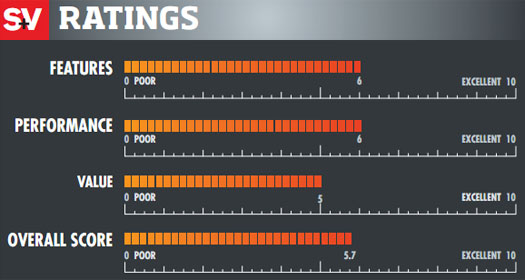Test Report: Panasonic TC-L42d2 LCD HDTV Page 3
PERFORMANCE
Seeing as the TC-L42D2 is an edge-lit LED, the first thing I checked was the set's screen uniformity, both with black and white test patterns. Because the light source of the TV is located away from the center, in this case along the top and bottom of the screen, it's possible for the screen's center to be dimmer than its edges. In this case, I saw a slight light leakage along the top and bottom of the screen and also in the corners. This may be noticeable if you're watching a 2.35:1 movie, but it's not ob- jectionable. On a white full-screen test pattern, the center area appears slightly dimmer than the top and bottom, but I doubt you'd see this without test patterns. Off-axis performance is excellent - almost as good as plasma. The TC-L42D2's black level goes up slightly when you move away from the center of the screen, but it's vastly better here than with most other LCDs.

For a real-world test, I watched Sunshine, a sci-fi movie with plenty of dark scenes that will usually reveal any weak- nesses with LCDs. Performance here was excellent. The black of outer space was nicely dark, while the stars and lights on the Icarus II popped. The brightness of the sun was impressive (and practically true to life if you turned up the back- light). The light leakage in the corners was somewhat visible but not too bad. Colors were vibrant yet quite accurate. The greens of the ship's oxygen garden looked very lush.
Motion blur is a concern with any LCD, and increasing the refresh rate to 120 or 240 Hz can help considerably. I'm especially sensitive to motion blur and am rather annoyed by it. With the Panasonic's 120Hz Motion Picture Pro 4 set to Off, I watched an episode of Boardwalk Empire, some football, and an episode of Mythbusters. During Boardwalk, all the detail in each character's face and clothing would disappear when they moved, then sharpen up again when they stopped moving. It wasn't really any worse here than on other LCDs, but it was noticeable. With MPP4 set to Weak, motion resolution was much better. Since Boardwalk was originally shot on film, however, the picture exhibited the objectionable ultra-smoothness of motion interpolation, with everyone moving like on a daytime soap opera.
On the other hand, with football and Mythbusters (and anything else shot on video), MPP4 was all upside. Motion detail went way up, and there was no ultra- smoothness. Personally, I'd leave MPP4 on Strong for most content but switch it to Off when watching films. As occasionally annoying as motion blur can be, to me it's not nearly as annoying as motion-interpolation effects.
While running some deinterlacing test discs, I found the TC-L42D2 capable of picking up a 3:2 sequence with both 480i and 1080i content. The rotating bar pattern on the Spears & Munsil Benchmark Blu-ray tests how well a video processor can reproduce diagonal lines. Here it was decent but not great. There were small jaggies as the bar neared the end of the yellow section, before the green "good" section.
For SD tests, I used the HQV Benchmark DVD. Performance with the rotating bar pattern on this Benchmark disc was way below average, showing some jaggies almost all the way around. I next skipped to real video material, starting with my standard test from the Gladiator DVD at the end of Chapter 12. The camera flies over ancient Rome. Well, the "camera" flies over what someone thought ancient Rome looked like at the time. Regardless, there's lots of fine detail and diagonal lines in the rooftops. I had thought this test was becoming obsolete, but I was wrong. It looked horrible on the TC-L42D2. Rooftops had odd crosshatch patterns, and all the windows popped into severe jagged lines as the Coliseum scrolled toward the bottom of the screen. I tried switching the set's 3:2 mode manually (Off, On, and Auto are the only settings), but this did little to help performance. I haven't seen a TV perform this poorly on real SD material in a while.
BOTTOM LINE
The Panasonic TC-L42D2 offers a bright picture, great color, a decent contrast ratio, and fantastic off-axis viewing (for an LCD). If you're looking for a TV for watching sports, especially on sunny Sundays, it's fabulous. But for mixed-use or movie viewing, it has one considerable problem: Panasonic's own TC-42G25 plasma. For $200 less, you can get largely better performance, plus Viera Cast with all its Netflix and other streaming goodness. Will the G25 look as good in a sunny room? No, but it won't look bad and it'll perform better in most other aspects, including motion resolution.
I guess the TC-L42D2 is for those die-hard LCD fans inveterately biased against plasma for reasons that defy logic. The TC-L42D2 is arguably greener, if that's your thing, but as eco-friendly as I try to be, I can't see basing my purchase decision just on that. If you do, by all means. Otherwise, go with a G25 instead.













































